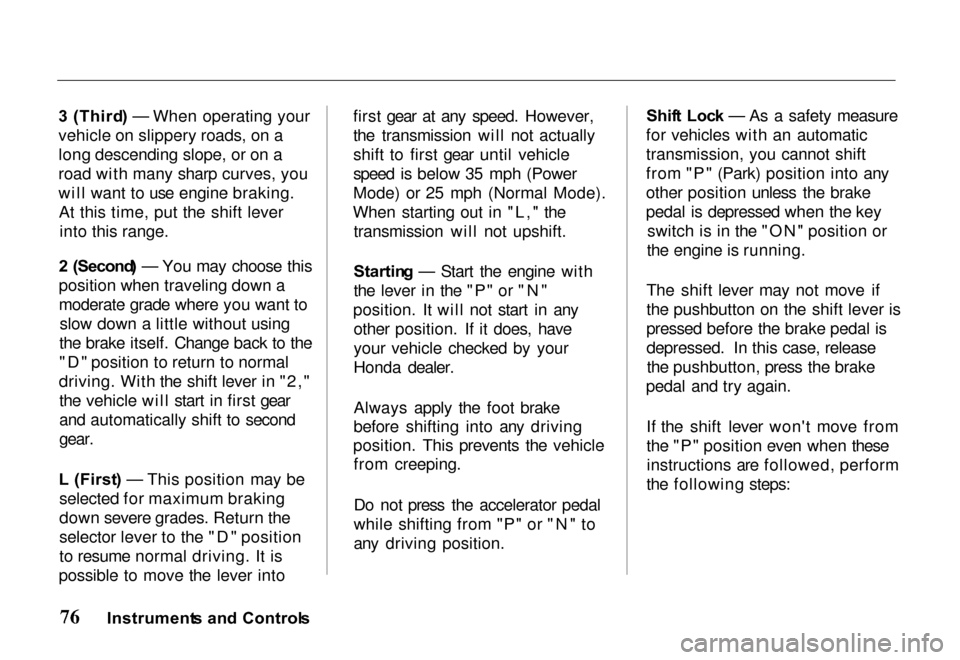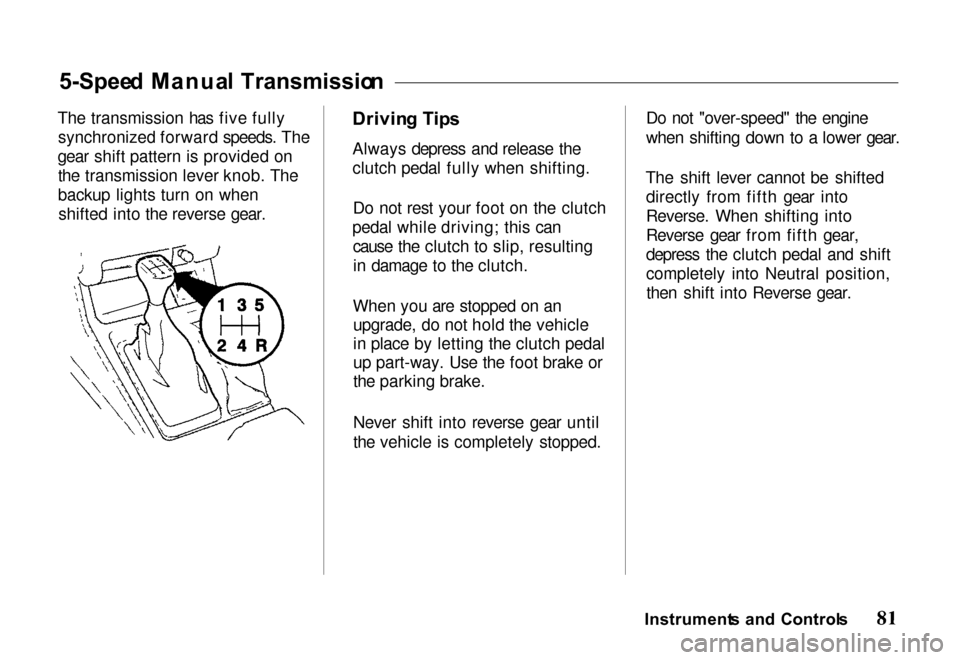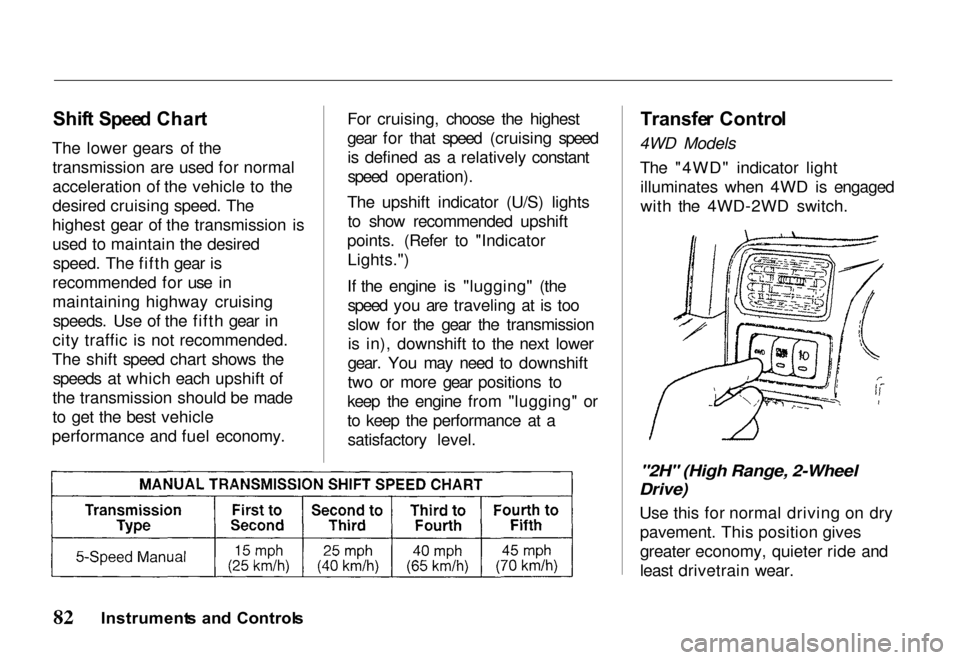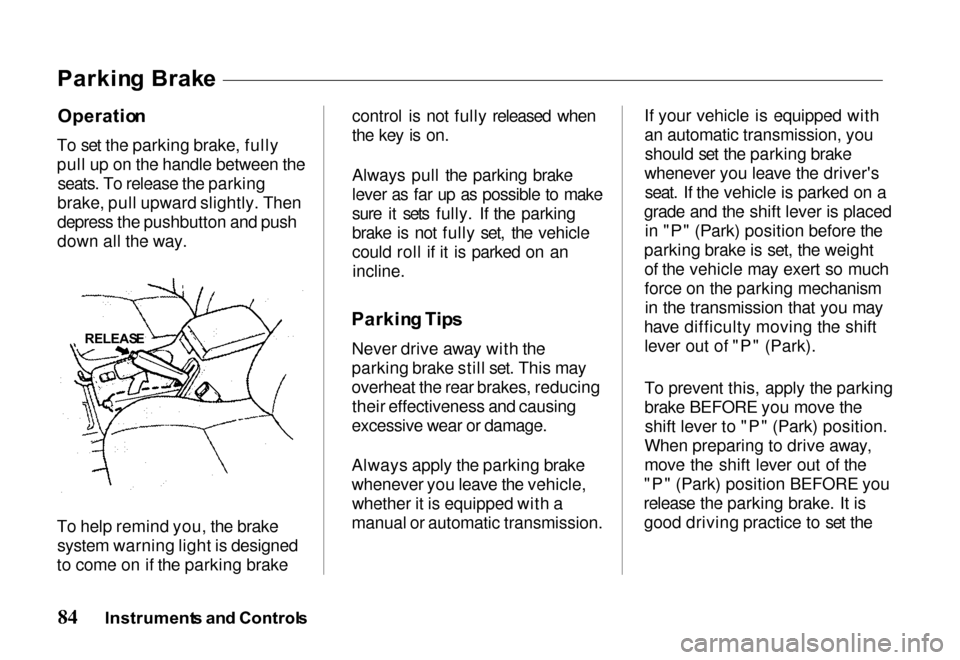2000 HONDA PASSPORT Transmission
[x] Cancel search: TransmissionPage 78 of 267

and the forward driving ranges.
The shift lever can be shifted freely into any position indicated by the arrow The lever
cannot be shifted into any position
indicated by the arrow
without pushing the button located on the end of the shift
lever. In this 4-speed automatic
transmission, the following three
modes can be selected by pressing the "POWER" or "WINTER"switch on the floor console, with
the key switch in the "ON"
position: NORMAL mode
POWER mode
WINTER mode
P (Park ) — Used to lock the
transmission when the vehicle is
parked or while starting the engine. Never move the shift lever
to Park until your vehicle is fullystopped. Use this position
together with the parking brake.
The shift lever can be moved from
PARK position if the regular brake is applied.
Refer to "Starting" in this section.R (Reverse ) — Used for backing
the vehicle. Bring your vehicle to a complete stop before shifting to
Reverse.
N (Neutral ) — The out-of-gear
position. You may restart a stalled
engine while the vehicle is still moving with the selector in
Neutral. Refer to "Starting" in thissection. This position is also used
when towing the vehicle. See "In
Case of Emergency" for towing information.
D (Drive ) (Firs t t o Fourt h
Gear ) — This position is for all
normal forward driving. For
normal driving, we recommend that you put the shift lever in the
"D" range. This will reduce
vehicle noise and improve fuel
economy.
Instrument s an d Control s
PAR
K
RE V
NEU T
DRIV E
3R D
2N D
1S T
Page 79 of 267

3
(Third ) — When operating your
vehicle on slippery roads, on a
long descending slope, or on a
road with many sharp curves, you
will want to use engine braking. At this time, put the shift lever into this range.
2 (Second ) — You may choose this
position when traveling down a
moderate grade where you want to slow down a little without using
the brake itself. Change back to the
"D" position to return to normal
driving. With the shift lever in "2," the vehicle will start in first gear
and automatically shift to second
gear.
L (First ) — This position may be
selected for maximum braking
down severe grades. Return the
selector lever to the "D" position
to resume normal driving. It is
possible to move the lever into first gear at any speed. However,
the transmission will not actually
shift to first gear until vehicle
speed is below 35 mph (Power
Mode) or 25 mph (Normal Mode).
When starting out in "L," the transmission will not upshift.
Startin g — Start the engine with
the lever in the "P" or "N"
position. It will not start in any other position. If it does, have
your vehicle checked by your
Honda dealer.
Always apply the foot brake
before shifting into any driving
position. This prevents the vehicle from creeping.
Do not press the accelerator pedal
while shifting from "P" or "N" to
any driving position. Shif
t Loc k — As a safety measure
for vehicles with an automatic
transmission, you cannot shift
from "P" (Park) position into any
other position unless the brake
pedal is depressed when the key switch is in the "ON" position or
the engine is running.
The shift lever may not move if
the pushbutton on the shift lever is
pressed before the brake pedal is
depressed. In this case, release the pushbutton, press the brake
pedal and try again.
If the shift lever won't move from
the "P" position even when theseinstructions are followed, perform
the following steps:
Instrument s an d Control s
Page 80 of 267

1. Check that the parking brake
is fully applied.
2. Turn the key switch to "ACC" position.
3. Move the shift lever from "P" to "N" position, depress the
brake pedal, and start the
engine again.
4. Operate the shift lever.
Have the transmission checked by
your Honda dealer as soon as
possible. Drivin
g Tip s
Before going down a steep or long
grade, reduce speed and shift the
transmission into a lower gear or
range to control the vehicle's speed. This will provide engine
braking to help slow the vehicle.
Try not to hold the brake pedal
down too long or too often. This
could cause the brakes to get hot
and not work properly.
Downshifting to a lower gear is
especially important when towing a trailer in mountainous terrain.
Do not hold the vehicle on a hill
by pressing on the accelerator. Do
not press on the accelerator pedal and brake pedal at the same time.
Either of these actions can
overheat the automatic
transmission and cause damage. Always keep your foot off the
accelerator pedal when shifting
from "P" or "N" to another gear.
Do not shift to "P" (Park) when
the vehicle is moving; you could
damage the automatic
transmission. Always come to a
complete stop.
Be careful that you do not exceed
the following maximum allowable speeds when accelerating.
Instrument s an d Control s
mph (km/h)
Page 82 of 267

Shifting the Transfer Control
Lever
4H 4L: Stop the vehicle. Place
the transmission leverin "N" (Neutral)
position. Then move the transfer controllever from 4H to 4L,
or 4L to 4H.
Move the transfer control lever
quickly and securely between
positions. Do not stop midway.
The transfer gear box can be
damaged if the control lever is not
firmly in gear. Some noise is
normal when shifting.
Always stop the vehicle before shifting between low and high range (4H 4L or 4L 4H).
If the 4WD indicator continues to
blink rapidly, it indicates that the system was shifted out of
sequence. Stop the vehicle, select 4WD with the 4WD-2WD switch,
shift the lever from 4L to 4H, then
select 2WD. Drive in a straight
line to reset the system. If the indicator continues to blink, see
your Honda dealer.
Do not use 4-wheel drive for
driving on dry pavement. This
causes noise and wear, and taking
tight turns can damage thetransfer case and driveshafts. It
also reduces fuel economy.
Be careful that you do not exceed
the following maximum allowable speeds when accelerating.
Drivin
g Patter n Selecto r
You can select a driving pattern suitable for existing driving
conditions.
When neither "POWER" nor
"WINTER" lights are illuminated, the normal driving program for
general driving conditions is
operative.
Instrument s an d Control s
Page 83 of 267

When more powerful acceleration
is needed, select the "POWER"
driving program. The "POWER
DRIVE" indicator light comes on when the driving pattern selector is set in the "POWER" position.
Push the button again to turn it
off.
Under inclement weather
conditions that cause slippery
roads, activating the "WINTER" mode will improve driving
operation. The "WINTER" mode may be activated while driving atspeeds of 6 mph (10 km/h) or less.
With the transmission lever in the
"P," "R," "N," or "D" position,
push the "WINTER" button on the
console.
The "WINTER DRIVE" indicator
light will illuminate whenever the
"WINTER" mode system is
activated, and the vehicle will
start off in third gear.
The "WINTER" mode is deactivated when the vehicle
reaches approximately 19 mph (30 km/h), when the transmission
is shifted into "3," "2," or "L," by
pushing the "WINTER" button again, or by turning the ignition
key to the "OFF" position. Operation of the "WINTER"
mode should be limited to
slippery road conditions only.
Operation of the "WINTER"
mode during normal driving
conditions will cause decreased
performance and sluggish
acceleration.
Instrument s an d Control s
Page 84 of 267

5-Spee
d Manua l Transmissio n
The transmission has five fully synchronized forward speeds. The
gear shift pattern is provided on the transmission lever knob. The
backup lights turn on whenshifted into the reverse gear. Drivin
g Tip s
Always depress and release the
clutch pedal fully when shifting.
Do not rest your foot on the clutch
pedal while driving; this can cause the clutch to slip, resultingin damage to the clutch.
When you are stopped on an upgrade, do not hold the vehicle
in place by letting the clutch pedal
up part-way. Use the foot brake or
the parking brake.
Never shift into reverse gear until
the vehicle is completely stopped. Do not "over-speed" the engine
when shifting down to a lower gear.
The shift lever cannot be shifted directly from fifth gear into
Reverse. When shifting into
Reverse gear from fifth gear,
depress the clutch pedal and shift
completely into Neutral position,then shift into Reverse gear.Instrument s an d Control s
Page 85 of 267

Shif
t Spee d Char t
The lower gears of the transmission are used for normal
acceleration of the vehicle to the
desired cruising speed. The
highest gear of the transmission is used to maintain the desiredspeed. The fifth gear is
recommended for use in
maintaining highway cruising speeds. Use of the fifth gear in
city traffic is not recommended.
The shift speed chart shows the speeds at which each upshift of
the transmission should be made
to get the best vehicle
performance and fuel economy. For cruising, choose the highest
gear for that speed (cruising speed
is defined as a relatively constant
speed operation).
The upshift indicator (U/S) lights to show recommended upshift
points. (Refer to "Indicator Lights.")
If the engine is "lugging" (the speed you are traveling at is too
slow for the gear the transmissionis in), downshift to the next lower
gear. You may need to downshift
two or more gear positions to
keep the engine from "lugging" or
to keep the performance at a satisfactory level.
Transfe
r Contro l
4WD Models
The "4WD" indicator lightilluminates when 4WD is engaged
with the 4WD-2WD switch.
"2H" (High Range, 2-Wheel
Drive)
Use this for normal driving on drypavement. This position gives
greater economy, quieter ride and
least drivetrain wear.
Instrument s an d Control s
Page 87 of 267

Operatio
n
To set the parking brake, fully
pull up on the handle between the seats. To release the parking
brake, pull upward slightly. Then
depress the pushbutton and push
down all the way.
To help remind you, the brake system warning light is designed
to come on if the parking brake control is not fully released when
the key is on.
Always pull the parking brake
lever as far up as possible to make
sure it sets fully. If the parking
brake is not fully set, the vehicle
could roll if it is parked on an
incline.
Parkin g Tip s
Never drive away with the
parking brake still set. This may
overheat the rear brakes, reducing their effectiveness and causing
excessive wear or damage.
Always apply the parking brake
whenever you leave the vehicle, whether it is equipped with a
manual or automatic transmission. If your vehicle is equipped with
an automatic transmission, you
should set the parking brake
whenever you leave the driver's seat. If the vehicle is parked on a
grade and the shift lever is placed in "P" (Park) position before the
parking brake is set, the weight of the vehicle may exert so much
force on the parking mechanismin the transmission that you may
have difficulty moving the shift lever out of "P" (Park).
To prevent this, apply the parking
brake BEFORE you move theshift lever to "P" (Park) position.
When preparing to drive away,
move the shift lever out of the
"P" (Park) position BEFORE you
release the parking brake. It is good driving practice to set the
Instrument s an d Control s
Parkin
g Brak e
RELEAS E